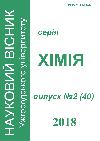ТЕЛУРОЦИКЛІЗАЦІЯ КОНДЕНСОВАНИХ N-АЛКЕНІЛЬНИХ ПОХІДНИХ 4-ОКСОПІРИМІДИН-2-ТІОНУ
DOI:
https://doi.org/10.24144/2414-0260.2018.2.46-48Ключові слова:
electrophilic heterocyclization, tellurium tetrachloride, 3-alkenyl-2-thioquinazolin-4-ones, thiazolidinequinazolones hydrochloridesАнотація
The derivatives of quinazolines and their fused analogues are promising objects for the rational design of biologically active compounds as prototypes for innovative medicines. This is due to the fact that the quinazoline fragment is a structural unit of many natural alkaloids. Electrophilic intramolecular heterocyclization is a promising method for the synthesis of fused derivatives of quinazoline.
This research is devoted to the synthesis of new functionalized unsaturated condensed derivatives of quinazolin-4-one and the study of the regio chemistry of the process of electrophilic heterocyclization under the action of tellurium tetrachloride. The choice of such an electrophilic reagent is due to the fact that in recent years the organic synthesis of chalcogen-containing compounds, in particular, tellurium compounds that exhibit a wide range of biological activity, is increasingly developing.
It was established that the electrophilic intramolecular cyclization of 3-alkenyl-2-thioquinazolin-4-one under the action of tellurium tetrachloride in an aqueous acetic acid medium at room temperature takes place with the participation of the alkenyl moiety and the exocyclic sulfur atom in the second position of quinazoline. As a result, thiazolidinequinazoline systems of linear structure were obtained. The structure and composition of the obtained tellurium-containing hydrochlorides has been proved by 1H, 13C NMR spectra and elemental analysis. In the PMR spectrum of hydrochlorides, signals of aliphatic cyclic methylene and methine groups and of the acyclic trichlorotellanylmethyl group are observed, which, together with the signals of aromatic protons, indicates on the formation of thiazolidinequinazolones. The absence of signals characteristic of the C=S group and presence of signals typical for the C-S bond in the 13C NMR spectra are in accord with the proposed structure of the cyclization products.
Thus, we investigated the regio chemistry of the electrophilic intramolecular cyclization of 3-alkenyl-2-thioquinazolin-4-one under the action of tellurium tetrachloride. It was proved that the annelation of the thiazolidine cycle takes place with the participation of the sulfur atom in the second position of the pyrimidine, with the formation of tricyclic hydrochlorides of linear structure.Посилання
Aniszewski T. Alkaloids – secrets of life. В.: Amsterdam, 2007, P. 316.
Armarego W.L.F. Chemistry of Heterocyclic Compounds: Fused Pyrimidines. Part I. Quinazolines. 2008, 24, 518.
Michael J.P. Quinoline, Quinazoline and Acridone Alkaloids. Nat. Prod. Rep. 2005, 22, 627–646.
Wippich P., Gutschow M. Regioselective Preparation of 1-(Bromomethyl)-5H-thiazolo [3,2-a]quinazolin-5-ones and Analogous 5H-Thieno[3,2-e]thiazolo[3,2-a]pyrimidin-5-ones from Fused 2-(Alkenylthio)pyrimidin-4-ones. J. Org. Chem. 2000, 714–720.
Orysk V.V., Zborovsky Yu.L., Staninets V.I., Dobosh A.A., Khripak S.M. Synthesis of thiazino and thiazolequinazolinones by cyclization of S-(2-propenyl) derivatives of 2-thioxo-2,3-dihydro-4 (1H)-quinazolinone. Chem. Heterocycl. Compd. 2003, 5, 739–744.
Zborovsky Yu.L., Khripak S.M., Staninets V.I. Synthesis of thiazolo and thiazino [3,2a] quinazoline derivatives. Ukr. khim. zhurn. 2002, 68(12), 95–99 (in Ukr.).
Martynov A.V., Makhaeva N.A., Larina L.I., Amosova S.V. Bis-E-chloromethylidene derivatives of 4-thio- and 4-selenomorpholinamines. Chem. Heterocycl. Compd. 2012, 48(9), 1425–1427.
Potapov V.A., Musalov M.V., Musalova M.V., Amosova S.V. Reaction of tellurium tetrachloride with acetylene. Russ. Chem. Bull. 2009, 58(11), 2404–2405.
Amosova S.V., Martynov A.V., Shagun V.A., Musalov M.V., Larina L.I., Krivdin L.B., Zhilitskaya L.V., Voronkov M.G. Anti-Markovnikov addition of tellurium tetrachloride to trimethyl ethynyl silane. J. Organomet. Chem. 2008, 693, 2509–2513.
Kut M., Onysko M., Lendel V. Heterocyclization of 5,6-Disubstituted 3-alkenyl-2-thioxothieno[2,3-d]pyrimidin-4-one with p-Alkoxyphenyltellurium trichloride. Heterocycl. Cоmmun. 2016, 22(6), 347–350.
Kut M., Onysko M., Lendel V. The Influence of Condensed Cycle on Regiochemistry of Electrophilic Heterocyclization of 3-Alkenyl-2-Thioxopyrimidin-4-One by p-Alkoxyphenyltellurium Trichloride: Regiochemistry of Electrophilic Heterocyclization of 3-Alkenyl-2-Thioxopyrimidin-4-One by p-Alkoxy-phenyltellurium Trichloride. J. Heterocycl. Chem. 2018, 55(4), 888–892.
Cunha R.L.O.R., Urano M.E., Chagas J.R., Almeida P.C., Bincoletto C., Tersariolb I.L.S., Comasseto J.V. Telluriumbased cysteine protease inhibitors: evaluation of novel organotellurium(IV) compounds as inhibitors of human cathepsin B. Bioorg. Med. Chem. Lett. 2005, 15, 755–760.
Abondanza T.S., Oliveira C.R., Barbosa C.M.V., Pereira F.E.G., Cunha R.L.O.R., Caires A.C.F., Comasseto J.V., Queiroz M.L.S., Valadares M.C., Bincoletto C. Bcl-2 expression and apoptosis induction in human HL-60 leukaemic cells treated with a novel organotellurium(IV) compound RT-04. Food Chem. Toxicol. 2008, 46, 2540–2445.
Cunha R.L.O.R., Gouvea I.E., Juliano L. A glimpse on biological activities of tellurium compounds. Ann. Braz. Acad. Sci. 2009, 81, 393–407.
##submission.downloads##
Номер
Розділ
Ліцензія
Ліцензування
Стаття та будь-який пов’язаний з нею опублікований матеріал поширюється за ліцензією Attribution-NonCommercial 4.0 International (CC BY-NC 4.0)
Умови цієї ліцензії не впливають на права автора чи іншого творчого виконавця захищати цілісність і право власності на свою роботу.
Авторське право на макет журналу та обкладинки повністю належить ДВНЗ "Ужгородський національний університет".
Весь контент публікується добросовісно, і думки, висловлені авторами, є тільки їхніми та не обов’язково відображають точку зору ДВНЗ "Ужгородський національний університет".
Автори надають редакційно-видавничому відділу ДВНЗ "Ужгородський національний університет" ліцензію на публікацію статті та ідентифікують себе як першовидавця.
Авторське право
Авторські права на будь-яку статтю зберігаються за автором(ами).
Публікацію статті мають схвалити всі автори та відповідальні органи інститутів, в яких виконувалося дослідження, якщо такі є.
Автори можуть уповноважити одного зі своїх співавторів діяти від їхнього імені та бути автором-кореспондентом, який відповідає за листування з редакційною командою журналу.
Автори можуть надати будь-якій третій стороні право вільно використовувати статтю за умови зазначення авторів та належного оформлення цитування.

